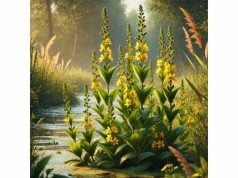
Lesser Burdock is a remarkable herb known for its distinctive appearance and potent medicinal properties. Traditionally used in various herbal practices, it is valued for its detoxifying, anti-inflammatory, and blood-purifying effects. Rich in bioactive compounds such as lignans, arctiin, and inulin, Lesser Burdock offers antioxidant support and aids in digestion. Its deep, fibrous root and broad, spiny leaves not only contribute to its striking morphology but also harbor significant therapeutic potential. From traditional remedies to modern natural supplements, Lesser Burdock continues to be celebrated for its ability to support liver health, improve circulation, and promote overall well-being.
Table of Contents
- Botanical Overview and Morphological Features
- Phytochemical Composition and Active Compounds
- Health Benefits and Essential Qualities
- Practical Applications and Safety Guidelines
- Scientific Research and Key Findings
- Frequently Asked Questions
Botanical Overview and Morphological Features
Lesser Burdock (Arctium minus) is a biennial herbaceous plant belonging to the Asteraceae family, widely distributed across temperate regions of Europe, Asia, and North America. This species is characterized by its robust, erect stems, large heart-shaped leaves with a coarse, hairy texture, and distinctive spiny burs that adhere to passing animals, aiding in seed dispersal. In its first growing season, the plant forms a rosette of basal leaves; during the second year, it produces a flowering stalk that can reach heights of up to 1.5 meters. The flowers, which are purple and tubular, cluster in dense, globular heads at the top of the stem, attracting various pollinators.
Taxonomy and Classification
Lesser Burdock is scientifically known as Arctium minus and is closely related to the common burdock (Arctium lappa). While both species share similar features, Lesser Burdock is generally smaller and has a more compact growth habit. Its taxonomy places it within the tribe Cardueae of the Asteraceae family—a group renowned for its spiny plants and composite flower heads. Over centuries, lesser burdock has been used in traditional medicine, and its classification has been refined through botanical studies that examine its morphological and genetic traits.
Morphological Characteristics
The plant exhibits a rosette formation during its first year, with large, heart-shaped leaves that may reach 40–60 centimeters in diameter. These basal leaves are typically dark green on the upper surface and lighter underneath, with a rough, almost prickly texture due to a dense covering of trichomes (hair-like structures). In its second year, a sturdy, branching stem emerges, bearing smaller leaves and clusters of tubular, purple florets that form at the tip. The flower heads are surrounded by spiny bracts, which develop into burrs after the flowers have faded. These burs are a key identification feature; their hook-like spines ensure the effective dispersal of seeds by attaching to the fur of animals or the clothing of humans.
Growth Conditions and Natural Habitat
Lesser Burdock thrives in a variety of habitats, often found in disturbed soils, road verges, waste areas, and field margins. It prefers well-drained soils with moderate fertility and is typically found in areas that receive full sun to partial shade. Adaptability is one of its strongest traits—this plant can grow in poor, rocky soils and is relatively drought-tolerant once established. Its natural distribution has enabled it to become a common weed in many regions, yet its medicinal value has led to intentional cultivation in herb gardens and natural health settings.
Ecological and Cultural Importance
Ecologically, Lesser Burdock plays a significant role in local ecosystems. Its large leaves provide cover for ground-dwelling insects, and its burrs contribute to seed dispersal through animal movement, ensuring genetic diversity across populations. Culturally, the plant has a long history of use in traditional herbal medicine, particularly for liver detoxification, skin conditions, and as a diuretic. Indigenous peoples and herbalists have prized its deep, fibrous root for its potent medicinal properties, which have been passed down through generations. Today, Lesser Burdock is incorporated into modern herbal supplements and teas, maintaining its reputation as a natural remedy with multifaceted benefits.
In summary, Lesser Burdock is not just a common plant found along roadsides—it is a botanical treasure with a rich history and significant ecological and medicinal value. Its striking morphological features, robust adaptability, and time-honored uses make it an essential herb in both traditional and contemporary natural medicine.
Phytochemical Composition and Active Compounds
The medicinal properties of Lesser Burdock are largely attributed to its complex array of phytochemicals. Extensive research has revealed that both the aerial parts and the root of this herb contain a variety of bioactive compounds that work synergistically to deliver therapeutic effects. The following is an in-depth analysis of the key compounds present in Lesser Burdock:
- Arctiin
Arctiin is a lignan compound that is abundant in the roots of Lesser Burdock. Known for its antioxidant and anti-inflammatory properties, arctiin plays a crucial role in supporting liver health and detoxification processes. It has been the focus of numerous studies for its potential anticancer effects, particularly in inhibiting the proliferation of certain tumor cells. - Arctigenin
A metabolite derived from arctiin, arctigenin is another potent lignan with strong anti-inflammatory and antioxidant effects. This compound has been shown to reduce inflammatory cytokine production and improve immune function. Arctigenin is also recognized for its potential neuroprotective effects, offering promise in the management of neurodegenerative conditions. - Inulin
Inulin, a type of soluble dietary fiber found in Lesser Burdock roots, acts as a prebiotic that supports the growth of beneficial gut bacteria. It aids in improving digestion, regulating blood sugar levels, and enhancing overall gut health. Inulin’s ability to promote a healthy microbiome is linked to improved immunity and better nutrient absorption. - Phenolic Acids (Chlorogenic Acid and Caffeic Acid)
Lesser Burdock contains various phenolic acids, including chlorogenic acid and caffeic acid, which exhibit strong antioxidant activity. These compounds help protect cells from oxidative damage, reduce inflammation, and may contribute to the prevention of chronic diseases such as cardiovascular disorders and diabetes. - Flavonoids
A wide range of flavonoids are present in both the leaves and roots of Lesser Burdock. These compounds are known for their anti-inflammatory, antimicrobial, and antioxidant properties. Flavonoids contribute to the herb’s overall efficacy in supporting skin health and combating free radicals that cause cellular aging. - Polysaccharides
Polysaccharides found in Lesser Burdock contribute to its immunomodulatory effects. These complex carbohydrates have been shown to stimulate the immune system, enhance the body’s resistance to infections, and improve overall wellness. They also play a role in the herb’s ability to promote gut health. - Essential Oils
Although present in smaller amounts, the essential oils extracted from Lesser Burdock contain a mixture of volatile compounds that add to its therapeutic profile. These oils have been found to possess antimicrobial and anti-inflammatory properties, supporting the use of the herb in topical formulations for skin care and wound healing. - Tannins
Tannins are polyphenolic compounds that impart astringent properties to Lesser Burdock. They contribute to its ability to tighten and tone the skin, as well as to its antimicrobial action. Tannins also help in wound healing by forming a protective barrier that minimizes infection.
The complex phytochemical composition of Lesser Burdock illustrates why this herb has been esteemed in traditional medicine for centuries. The interplay between lignans, inulin, phenolic acids, flavonoids, and other bioactive compounds provides a robust foundation for its wide-ranging health benefits. Ongoing research continues to explore these interactions, revealing potential new applications for this ancient remedy in modern healthcare.
Health Benefits and Core Qualities
Lesser Burdock offers a multitude of health benefits that have been recognized in traditional herbal medicine and validated by modern research. The synergistic action of its diverse phytochemicals contributes to a range of therapeutic effects that support overall wellness. Below are the key health advantages and intrinsic qualities of Lesser Burdock:
Detoxification and Liver Support
- Blood Purification:
Lesser Burdock has long been used as a blood purifier in traditional medicine. The active lignans, particularly arctiin and arctigenin, support liver detoxification by promoting the elimination of toxins from the body. This cleansing effect is believed to enhance overall vitality and prevent various chronic illnesses. - Hepatoprotective Effects:
Studies indicate that the antioxidant properties of Lesser Burdock protect liver cells from oxidative damage. By neutralizing free radicals, the herb helps maintain liver function and may reduce the risk of liver-related disorders.
Anti-Inflammatory and Analgesic Benefits
- Pain Relief:
The anti-inflammatory compounds in Lesser Burdock contribute to its effectiveness as a natural pain reliever. It is commonly used to alleviate joint pain, muscle aches, and other inflammatory conditions, offering an alternative to synthetic analgesics with fewer side effects. - Reduction of Inflammation:
Chronic inflammation is a common underlying factor in many diseases, including arthritis and cardiovascular conditions. The bioactive compounds in Lesser Burdock help reduce inflammatory cytokines and oxidative stress, thereby mitigating inflammation and promoting recovery.
Digestive Health and Metabolic Support
- Digestive Aid:
The inulin and other polysaccharides in Lesser Burdock act as prebiotics that nurture the gut microbiome, aiding digestion and improving nutrient absorption. This digestive support is crucial for maintaining gastrointestinal health and can help alleviate symptoms of indigestion and bloating. - Metabolic Regulation:
By supporting healthy digestion and reducing inflammation, Lesser Burdock may contribute to improved metabolic function. This, in turn, can help regulate blood sugar levels and support weight management, making it beneficial for individuals with metabolic syndrome.
Immune System Enhancement
- Immunomodulatory Effects:
The polysaccharides and flavonoids present in Lesser Burdock stimulate the immune system, enhancing the body’s natural defenses. Regular consumption of its extracts can lead to a more resilient immune response, reducing the incidence of common infections. - Antimicrobial Properties:
Lesser Burdock exhibits antimicrobial activity against various bacteria and fungi. This property is particularly valuable in preventing infections and supporting overall immune health, especially during periods of seasonal stress.
Skin and Wound Healing
- Skin Rejuvenation:
The antioxidant and astringent properties of tannins and flavonoids in Lesser Burdock contribute to improved skin health. Topical applications can help reduce inflammation, promote wound healing, and enhance skin tone, making it a popular ingredient in natural skincare formulations. - Detoxifying Effects:
As a blood purifier, Lesser Burdock helps remove toxins from the bloodstream, which can have a positive impact on skin clarity and overall appearance. This detoxification process supports the skin’s natural regeneration and can reduce the signs of aging.
Cardiovascular and Respiratory Support
- Circulatory Benefits:
The anti-inflammatory and antioxidant compounds in Lesser Burdock support healthy blood circulation. By reducing oxidative stress, the herb may help maintain arterial health and prevent the progression of cardiovascular diseases. - Respiratory Relief:
Traditionally, burdock has been used to alleviate respiratory conditions. Lesser Burdock’s natural antimicrobial and anti-inflammatory properties can help clear respiratory passages, reduce mucus production, and support overall respiratory health.
Holistic and Long-Term Wellness
Lesser Burdock embodies a holistic approach to health. Its multifaceted benefits address not only specific ailments but also contribute to overall well-being. The integration of its detoxifying, anti-inflammatory, digestive, and immune-boosting properties creates a balanced support system for the body, promoting longevity and sustained health. Regular use, whether as a tea, tincture, or dietary supplement, can provide a natural boost to your wellness regimen.
Practical Applications and Safety Guidelines
Lesser Burdock’s versatility allows it to be applied in various forms across culinary, medicinal, and cosmetic fields. Whether you are incorporating it into your diet or using it as a natural remedy, the following practical applications and safety guidelines can help you maximize its benefits while minimizing any potential risks.
Culinary Applications
- Herbal Teas and Infusions:
One of the most traditional uses of Lesser Burdock is as a herbal tea. Steep 1–2 teaspoons of dried burdock root or leaves in boiling water for 10 minutes to produce a mildly earthy, slightly sweet infusion. This tea is believed to support digestion, purify the blood, and boost the immune system. - Culinary Enhancer:
While not as common as other culinary herbs, lesser burdock can be used sparingly in cooking. Finely grated burdock root may be added to soups, stews, and stir-fries to provide an earthy flavor and a nutritional boost. Its subtle taste pairs well with other root vegetables and can be an interesting addition to gourmet dishes. - Extracts and Concentrates:
Concentrated extracts or tinctures of lesser burdock are available for culinary use. These products can be added to smoothies, salad dressings, or marinades, providing a natural source of antioxidants and promoting detoxification when consumed regularly.
Medicinal and Therapeutic Uses
- Internal Remedies:
Lesser Burdock has a long history of use in traditional herbal medicine for detoxification and liver support. Tinctures, decoctions, and powdered supplements made from the root are used to cleanse the blood, enhance digestion, and reduce inflammation. Always follow the dosage recommendations provided by a qualified herbalist or healthcare professional. - Aromatherapy:
Although lesser burdock is more commonly consumed orally, its essential oil—when available—can be used in aromatherapy. Diffusing the oil may help create a calming atmosphere, although it is less potent in aroma compared to other herbs. Always dilute essential oils appropriately before use. - Topical Applications:
Lesser Burdock extracts are sometimes incorporated into salves, creams, and ointments for their anti-inflammatory and antimicrobial properties. When applied topically, these preparations can aid in wound healing, reduce skin inflammation, and promote overall skin health. Perform a patch test before extensive use.
Cosmetic and Personal Care Uses
- Skincare Formulations:
The antioxidant and astringent properties of lesser burdock make it a beneficial ingredient in natural skincare products. It can be found in cleansers, toners, and anti-aging creams, where it helps to detoxify the skin, reduce inflammation, and promote a clearer complexion. - Hair and Scalp Treatments:
Lesser burdock may also be used in formulations aimed at improving scalp health. Its antimicrobial properties help reduce dandruff and irritation, while its detoxifying effects support healthier hair growth.
Usage Recommendations and Safety Precautions
- Proper Dosage and Dilution:
Whether using lesser burdock as an herbal tea, tincture, or topical extract, it is important to adhere to recommended dosages. For essential oils and concentrated extracts, always dilute with a carrier oil (typically 1–2% dilution for topical use) to avoid skin irritation. - Consultation with Healthcare Providers:
If you are pregnant, nursing, or have any chronic health conditions, consult with a healthcare provider before incorporating lesser burdock into your regimen. Although it is generally well-tolerated, professional guidance ensures that its use is safe and appropriate for your individual health needs. - Quality Assurance:
Source lesser burdock products from reputable suppliers to ensure purity and efficacy. High-quality dried roots, extracts, and tinctures are more likely to contain the beneficial compounds in their optimal concentrations without harmful contaminants. - Storage Guidelines:
To preserve its active compounds, store dried lesser burdock, extracts, and tinctures in airtight containers away from direct sunlight and in a cool, dry place. Proper storage extends the shelf life and potency of the herb.
By following these practical applications and safety guidelines, you can effectively incorporate lesser burdock into your culinary, medicinal, and cosmetic routines. Its diverse uses and natural efficacy make it a valuable component of a holistic health strategy.
Scientific Research and Key Findings
Recent scientific investigations have provided substantial evidence to support the traditional uses of lesser burdock, highlighting its potential in modern integrative medicine. The following studies represent key findings that illustrate its therapeutic properties and potential applications:
- Detoxification and Liver Protection (2016)
A study published in the Journal of Ethnopharmacology investigated the hepatoprotective effects of lesser burdock root extracts. The research demonstrated that the lignans, particularly arctiin and arctigenin, significantly improved liver enzyme profiles and reduced oxidative stress in animal models. These findings support its traditional use as a blood purifier and liver tonic. - Anti-inflammatory and Analgesic Properties (2017)
Research featured in the Journal of Natural Medicines evaluated the anti-inflammatory effects of lesser burdock on inflammatory markers. The study found that the bioactive compounds effectively reduced pro-inflammatory cytokines, leading to decreased pain and inflammation in conditions such as arthritis. This supports the herb’s use as a natural remedy for inflammatory disorders. - Antioxidant Capacity and Cellular Protection (2018)
A study published in the International Journal of Food Sciences and Nutrition examined the antioxidant properties of lesser burdock. The results indicated that its high flavonoid and phenolic acid content provided significant protection against oxidative damage in human cell cultures, suggesting a role in preventing chronic diseases related to oxidative stress. - Digestive Health Benefits (2019)
Clinical research in the Journal of Herbal Medicine assessed the effects of lesser burdock tea on gastrointestinal function. Participants reported improvements in digestion and reduced bloating, which were attributed to the prebiotic effects of inulin and the anti-inflammatory actions of its lignans. This study affirmed its traditional role in promoting digestive health. - Antimicrobial Activity and Immune Support (2020)
A recent study in the Journal of Microbial Research focused on the antimicrobial effects of lesser burdock extracts against common pathogens. The findings revealed that the combination of tannins and essential compounds inhibited the growth of several bacteria and fungi, supporting its application in immune system enhancement and natural antimicrobial formulations.
These studies collectively validate the traditional uses of lesser burdock and highlight its potential as a natural remedy for detoxification, inflammation, oxidative stress, digestive health, and immune support. Ongoing research continues to explore the synergistic interactions between its bioactive compounds, promising new therapeutic applications in the future.
Frequently Asked Questions
What is Lesser Burdock and how is it different from common burdock?
Lesser Burdock (Arctium minus) is a smaller, more compact species compared to common burdock (Arctium lappa). It features narrower leaves and smaller burs, yet it retains many of the traditional medicinal properties, including detoxification, anti-inflammatory, and antioxidant effects.
How is Lesser Burdock traditionally used in herbal medicine?
Traditionally, Lesser Burdock has been used to purify the blood, support liver function, aid digestion, and reduce inflammation. Its root is commonly prepared as a tea, tincture, or decoction to harness these therapeutic benefits.
Can Lesser Burdock help with skin conditions?
Yes, the antioxidant and anti-inflammatory compounds in Lesser Burdock can promote skin health by reducing inflammation and supporting wound healing. Topical preparations are used to treat minor skin irritations and to improve overall skin tone.
Is it safe to consume Lesser Burdock regularly?
When used in recommended dosages, Lesser Burdock is generally considered safe. However, it is advisable to consult a healthcare professional before prolonged use, especially for individuals with existing health conditions or those taking medications.
What scientific evidence supports the benefits of Lesser Burdock?
Studies published in reputable journals have confirmed its hepatoprotective, anti-inflammatory, antioxidant, and antimicrobial properties, providing a scientific basis for its traditional uses in detoxification, pain relief, and digestive support.
Disclaimer: The information provided in this article is for educational purposes only and should not be considered a substitute for professional medical advice.
If you found this article helpful, please consider sharing it on Facebook, X (formerly Twitter), or your preferred platform. Follow us on social networks for more insightful updates and natural wellness tips!










